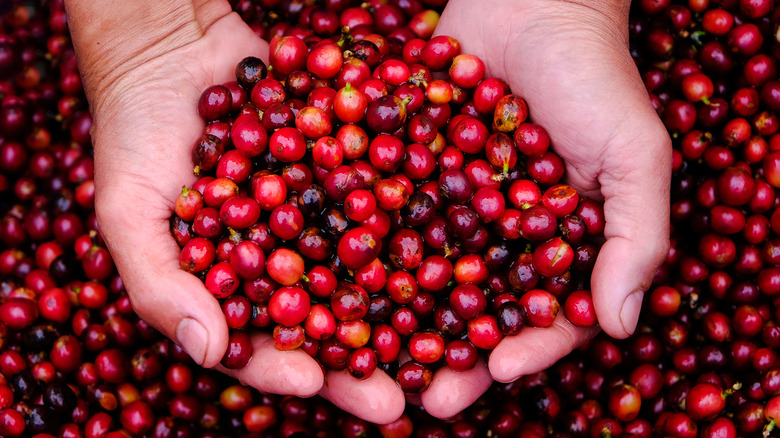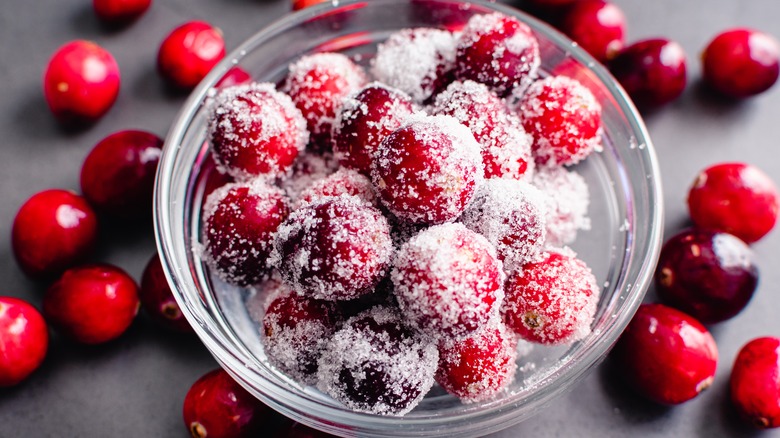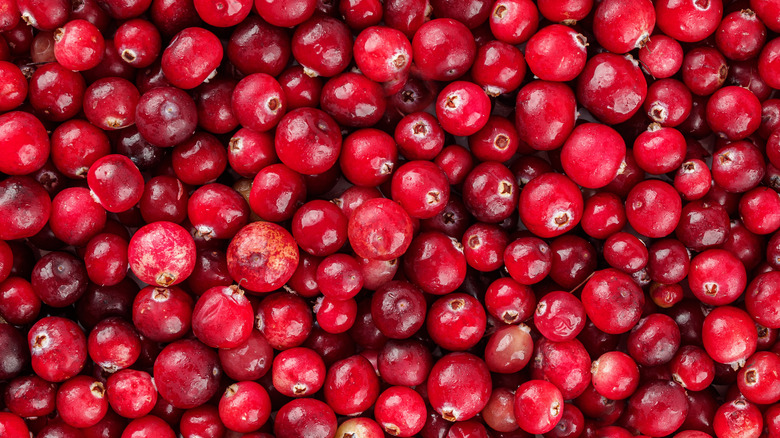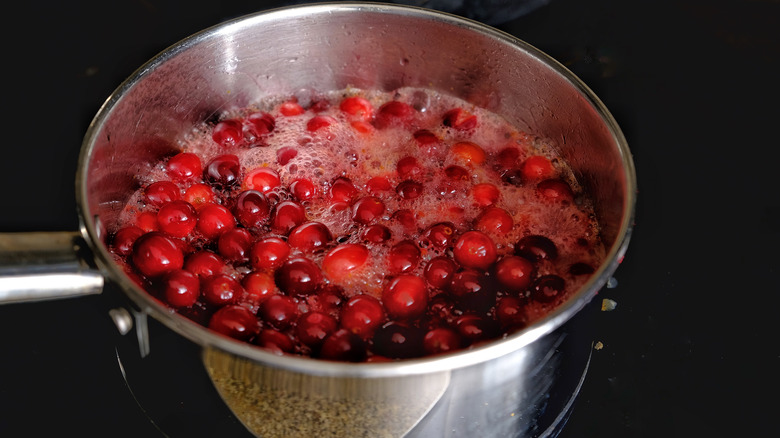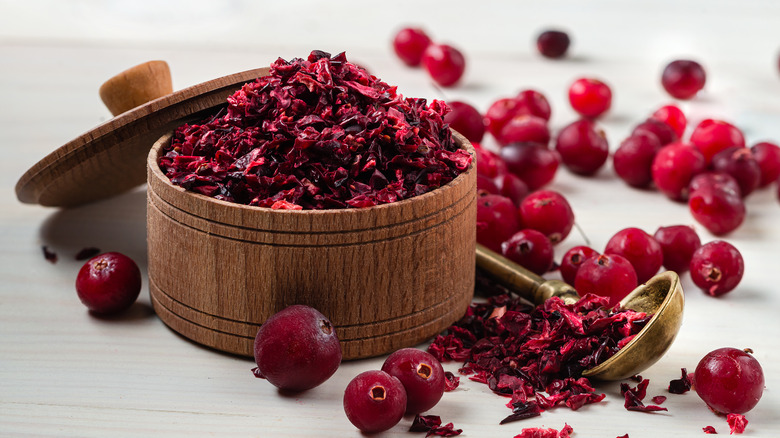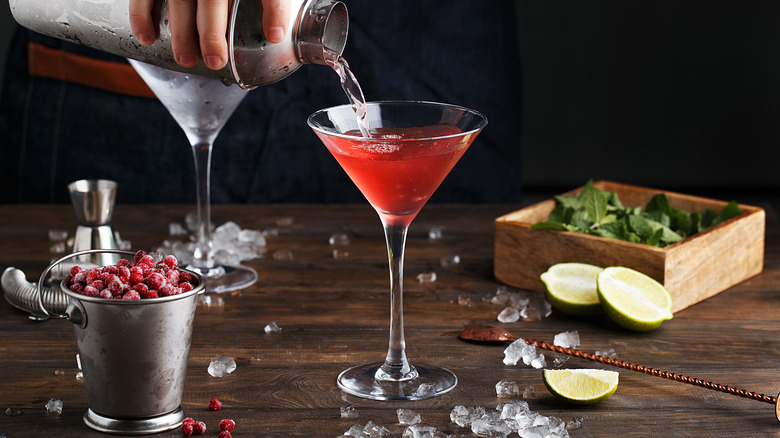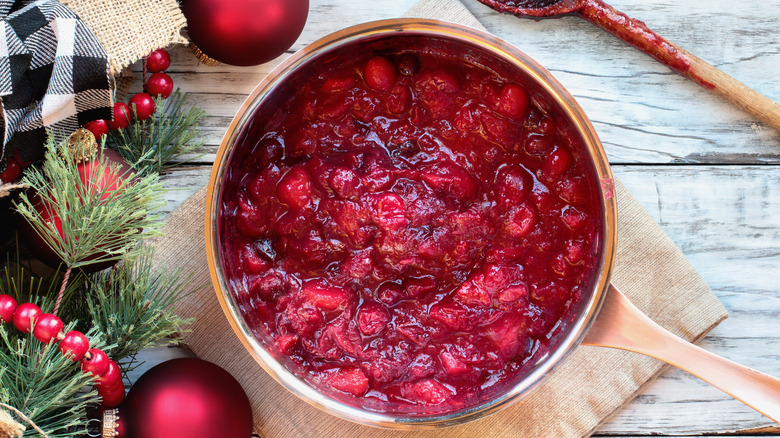11 Tips You Need When Cooking With Cranberries
By the time the air chills and November rolls around, cranberries return to the forefront of home cooking as the holiday season comes into full swing. Most commonly spotted on a Canadian or American Thanksgiving table, these little red bulbs found their rise to fame being featured in holiday feasts as a side dish to add tartness and flavor to turkey and other main meals. Though we are certainly more than grateful for their contribution to the holiday season and all things holiday-cheer, cranberries can make an appearance on the table in many other ways and on other occasions.
But, when cooking or using cranberries, first and foremost it is important to know exactly how to use these tart berries correctly. Get ready to become a professional with our tips and tricks for how to make sure your cranberries are cooked and prepped the right way, from start to finish.
Pick the best cranberries
According to Decas Farm, the peak harvesting season for cranberries is October through December. But, don't let this stop you from using frozen cranberries and appreciating them all year long! When shopping for fresh cranberries at the grocery store or at your local farmer's market for your meal-to-be, make sure to steer clear of any berries that look too soft or even dried and shriveled. Instead, take your time sorting through to select ripe cranberries that are plump and firm with a darker shade of red or even cranberries that lean towards a more yellowish-red.
Though it may seem like a small detail, making the time to do prep like this makes sure the rest of your cooking can happen smoothly without any unexpected bumps. If you're buying a bag of pre-selected berries from the grocery store, simply sort through them when you get home. If you have any softer cranberries, those can specifically be used for sauces and jams.
Combat the natural tartness
When it comes to cranberries, one thing is for sure: cranberries are known for their tartness. This comes as no surprise because they are actually one of the fruits that contain the lowest amount of sugar, with every cup of cranberries having a mere total of 4 grams. The quick and easy solution to activating the hidden natural sweetness in these fall berries is to add a little bit of sugar when you cook with them.
If boiling cranberries down on the stove, adding a bit of sugar and water will mellow out the flavor for any jams, sauces, or purées that you might prepare in the future. During the holiday season, sugared or candied cranberries are likely to make their way onto tabletops as a sweet treat. If you're wanting to try this out for our next hosted event, try coating fresh cranberries in cane or powdered sugar to counteract their tart and bitter flavor before freezing or placing them in the oven.
Use different methods of chopping and blending
The different ways to transform cranberries in the kitchen depend on whether they are raw, cooked, or dried. In order to create a smoother sauce or chutney, take a pot of cranberries that have already been cooked down in water or some other liquid and blend. When chopping raw cranberries by hand, make sure to first, remove stems and pick up a sharp knife.
Because chopping a small, round object can be rather difficult, and slicing them all individually can end up being pretty time-intensive, we have a quick tip for you! Living Scented provides a more efficient way to chop cranberries: Place a handful of raw cranberries on your cutting board, then place your non-cutting palm on the group to hold them steady, arching your fingertips to avoid being cut. Hold the knife at a 45-degree angle, and use a slicing motion to halve them before slicing into thin pieces.
Keep watch when cooking on the stovetop
Unless using cranberries in baking, these plump little red spheres need to be cooked on the stovetop. A method that usually leads to sauces, syrups and jams. The process of cooking down cranberries is fairly simple with one key tip: keep watch! Following the method from our cranberry sauce recipe, keep an eye out while placing the berries on the stove, so you'll notice when they split open — a sign that it is time to take them off the heat. Make sure to watch the berries carefully and take them off the heat before they cook to the point of becoming mushy.
Remember when we talked about cranberry's natural bitter flavor? This reduction method will also cause the flavor to turn more bitter. This can also be easily avoided by adding a bit of water and sugar while cooking them down. If you're looking for some inspiration, our savory recipe for cranberry sauce recommends simmering herbs in the liquids to add a bit of flavor!
Try different liquids to rehydrate dried cranberries
Let's be honest: As much of a cranberry fan you might consider yourself to be, by the time you read this article or have a burst of culinary inspiration, you might not have a bag of perfectly picked, fresh cranberries waiting for you in the kitchen. If time is not on your side, and you forgot to pick up fresh ones at your most recent trip to the grocery store, you might have some dried cranberries on hand. Soak them in hot water, and let stand for 15 to 20 minutes. Then strain before using the reconstituted cranberries in a recipe.
According to LiveStrong, even if you're not in the midst of peak cranberry season, rehydrating cranberries is recommended for baking purposes because any dried berries will only dry out more in the oven. You can also add a bit of extra flavor to the rehydrated cranberries by adding an orange peel or cinnamon stick to the water. Or, you can skip the water altogether, and rehydrate your dried cranberries in fruit juice or your favorite liquor instead. Let your creativity do the work here!
Freeze cranberries to keep on hand
Now that we're tempting you to make cranberries their very own food group, don't let the peak harvesting season restrict you by only enjoying cranberries during the holiday season! Fresh cranberries can be frozen at home, and we advise keeping cranberries frozen no longer than twelve months. During any season you can pull out a bag of frozen cranberries and use them directly in any type of recipe without needing to wait and thaw them out. To freeze, spread the cranberries evenly on a baking sheet and place them in the freezer for one hour before taking them out and grouping the berries together in a freezer bag. Keep frozen and use whenever you get a craving!
Don't worry, freezing the berries won't actually have much of an impact on changing your favorite cranberry recipes. Some recipes work even better using frozen berries rather than fresh ones! Cranberry orange muffins are a perfect way to utilize frozen cranberries.
Turn cranberries into a seasonal cocktail
Making cranberry juice at home is not only a lot easier than you'd think but tastes (dare we say it) better than the store-bought options. Following this method from Mother Earth News, place fresh cranberries in a small pot over low-medium heat on the stove and add water until the cranberries are just covered, along with a tablespoon or so of sugar (depending on the desired sweetness level). Then, let the cranberries boil down. Pour the cranberry mixture into a colander and slowly stir to separate the liquid from the larger chunks of cranberries, according to the site. This will take patience and love but soon, voila! Fresh cranberry juice!
Festive holiday drinks certainly take advantage of cranberry juice, but so do many other cocktails and mocktails, such as our personal favorite: The cosmopolitan, which is a concoction of Cointreau, citrus-flavored vodka, fresh lime juice, an orange twist, and of course, cranberry juice.
Add extra nutrition to recipes
Fun fact: Cranberries are an extremely nutrient-dense superfood. According to Medical News Today, research has linked the nutrients in cranberries to lowering the risk of a urinary tract infection and improving overall urinary tract health, as well as reducing cardiovascular disease, assisting with strengthening the immune system, and decreasing overall blood pressure. The berries are also extremely rich in antioxidants and have the highest phenol content in regularly consumed fruits within the U.S., according to the Journal of Agriculture Food chemistry.
To take advantage of all those health benefits, add some more nutrients to your diet by switching out other fruits and adding cranberries into recipes where they aren't normally listed. This can be in any type of recipe, such as substituting cranberries in muffins, cookies, and even cakes. Using cranberry sauce as an acidic component in meat dishes is also a great way to add more cranberries onto your plate.
Pair cranberries with the right flavors
Are you trying to get creative in your kitchen by coming up with recipes where you can use cranberries? When substituting cranberries in different recipes, or creating a whole dish around them, it is important to be aware of what other flavors pair well with them. According to the book, "The Art and Science of Food Pairing," a Swiss food chemist narrowed down food pairing to the molecular level, as in, well-paired flavors contain the same aroma molecules.
Luckily, we can rely on our own tastebuds and creativity to tell us what works. When experimenting with your own flavors, there will be lots of trial and error, but, we have some ideas. When it comes to other fruits, according to the flavor chart on the Bakers Almanac, cranberries pair well with apples, apricots, citruses, peaches, pears, pumpkin, and quince. Regarding spices, cranberries work best with allspice, cinnamon, cloves, ginger, thyme, and star anise. To sweeten cranberries (other than classic sugar), use honey, maple syrup, or vanilla. When it comes to nuts, almonds, hazelnuts, pistachios, and walnuts complement cranberries extremely well. Lastly, when approaching your local liquor store for a good pairing, look for cognac, grand mariner, or white wine to match your cranberry dish.
Revive your overcooked cranberries
Well, let's evaluate the actual problem if you're cranberries aren't the way you wanted. Did you get distracted while cooking, and what was meant to be a runny cranberry sauce, has actually turned into a chunky cranberry mash? If so, the heat caused too much liquid to be evaporated from the pot and the berries. Also, when berries continue to cook after being split open, they release pectin, which according the Healthline, is a natural thickener that causes the cranberry sauce to get chunky. The quick solution to this is to add more liquid and slowly stir the berries on low heat.
Now, on the other hand, did cooking your cranberries too long make them bitter and nearly inedible? If that's the case, don't toss them and start over — there's a way to revive them! Knowing what we now know about their tartness and the need to combat it, adding a bit of liquid, as well as a spoonful of sugar, can infuse a sweeter flavor into the berries and bring back the natural sweetness.
Make a cranberry simmer pot
There really is nothing that puts us in a warm and cozy spirit more than filling up our homes with yummy, festive smells. And when you aren't yearning for a meal, and actually eating cranberries isn't in the cards (yet you somehow still seem to have a few bags on hand?) ... opt for a simmer pot. This is a perfect all-natural and non-toxic solution to filling up your home with cozy holiday scents, and it is so easy to do!
To make your own simmer pot, you just need a flash of creativity (not to mention, a bit of patience). Simply set a pot of water on the stove to low heat. Start adding fresh cranberries, as well as citrus fruits and warm, fragrant spices. Use your nose and your tastebuds and spend some time experimenting. You can also use our favorite mix of cinnamon, cloves, and oranges — or even try a blend of rosemary and vanilla — to fill your home with inviting holiday cheer!
